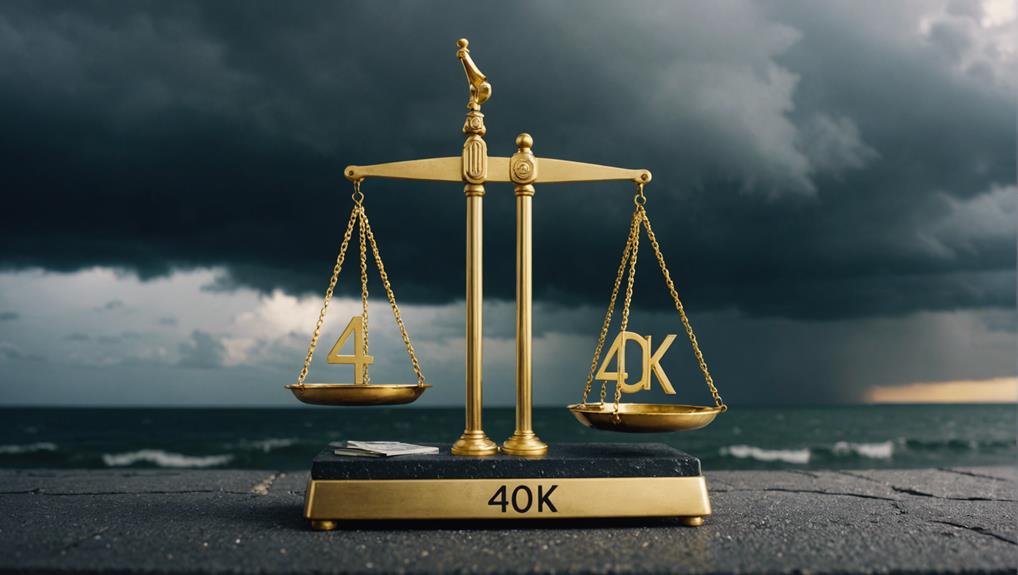Switching from a 401(k) to a Gold IRA involves several critical steps that should not be overlooked.
Understanding why diversifying your retirement savings with precious metals can be beneficial is essential. Gold IRAs offer unique advantages and come with their own set of risks.
Initiating this transition requires choosing the right custodian and managing tax implications carefully.
Focusing on these elements will prepare you for a smooth and compliant rollover process.
Ready to take the next steps?
My Quick Highlights
- Consult a financial advisor to understand the tax implications and rollover options.
- Choose a reputable, IRS-approved custodian for your Gold IRA.
- Decide between a direct or indirect rollover for transferring your 401(k) funds.
- Ensure your Gold IRA assets will be stored in an IRS-approved depository.
- Research and select a reliable gold investment company to facilitate the transition.
Overview of 401(k)

A 401(k) is a retirement savings plan that allows employees to contribute a portion of their salary, often with tax benefits. It plays a crucial role in retirement planning by enabling investments to grow tax-deferred. Participants can choose from various investment options such as stocks, bonds, and mutual funds. Employers frequently match contributions, which can significantly boost savings.
The IRS sets annual contribution limits, but individuals over 50 can make additional catch-up contributions. Understanding the rollover process is essential when transitioning your 401(k) to another investment vehicle, such as a Gold IRA. This can diversify your retirement portfolio, providing additional security and potential for growth.
Benefits of Gold Investment
Switching to a Gold IRA offers you several significant benefits. Gold can act as a hedge against inflation, helping to protect your savings from the eroding effects of rising prices.
Moreover, it diversifies your investment portfolio, providing long-term value preservation and stability.
Hedge Against Inflation
Investing in gold offers a reliable hedge against inflation, helping to preserve your purchasing power over time. Inflation often reduces the value of traditional investments like stocks and bonds.
Transitioning from a 401K to a Gold IRA can protect your assets from this devaluation, as gold's intrinsic value and scarcity make it a dependable store of wealth. Here's how gold serves as an inflation hedge:
- Value Preservation: Historically, gold maintains its value during periods of high inflation.
- Asset Protection: It shields your assets from the devaluing effects of inflation.
- Portfolio Diversification: Incorporating gold into your retirement portfolio diversifies your investments, enhancing stability.
Diversify Investment Portfolio
Integrating gold into your investment portfolio can provide essential diversification and stability. By adding a gold IRA, you create a hedge against stock market volatility. Gold often moves inversely to stocks, offering a counterbalance that reduces overall risk.
This diversification is particularly valuable during economic uncertainty when traditional assets might underperform. Gold investments also protect your portfolio from inflation and currency devaluation, helping to preserve your wealth over time.
Incorporating gold into your strategy strengthens the robustness of your portfolio, ensuring resilience through various market conditions. Diversifying with a gold IRA can help you achieve a more balanced and secure financial future.
Long-term Value Preservation
Exploring a Gold IRA for long-term value preservation can effectively safeguard your wealth against inflation and economic instability. Gold's historical value stability makes it a reliable choice for maintaining wealth.
Here are the key benefits:
- Inflation Hedge: Gold retains its value over time, protecting your savings from the eroding effects of inflation.
- Economic Stability: During economic downturns, gold often performs well, providing a safe haven for your investments.
- Tax Advantages: Gold IRAs offer specific tax benefits, allowing your investment to grow tax-deferred.
Investing in a Gold IRA could be a beneficial strategy for preserving your wealth in the long term.
Gold IRA Basics

Investing in a Gold IRA allows you to diversify your retirement portfolio with precious metals such as gold, silver, platinum, and palladium. Understanding the basics of a Gold IRA is crucial. A Gold IRA, typically a self-directed account, enables you to invest in physical metals, offering diversification beyond traditional assets.
For a seamless transition, a rollover IRA can facilitate the transfer of funds from a 401(k) without incurring tax penalties. A trustee, a financial institution approved by the IRS, is required to manage your account and ensure compliance with specific fineness standards for the metals.
Gold IRAs provide tax advantages and serve as a hedge against economic downturns and inflation. This diversification enhances the long-term stability of your retirement savings.
Opening a Gold IRA
To open a Gold IRA, begin by locating a reputable custodian who specializes in managing precious metals within retirement accounts. This custodian will guide you through the process and ensure compliance with IRS regulations.
Follow these steps:
- Select a Gold IRA custodian: Choose one with a proven track record in the industry.
- Pick approved gold coins or bars: Ensure they've a minimum fineness of .995.
- Use an IRS-approved depository: Your custodian will store your gold assets securely in a certified facility.
401(k) to Gold IRA Rollover

Switching your 401(k) to a Gold IRA involves understanding eligibility and requirements, following specific rollover process steps, and choosing a reliable custodian.
You'll need to ensure your current 401(k) plan allows for rollovers and meet IRS guidelines to avoid penalties.
Working with a reputable Gold IRA company can help you navigate these steps smoothly and secure your retirement investments.
Eligibility and Requirements
Eligibility and Requirements
Understanding the eligibility and requirements for a 401(k) to Gold IRA rollover is essential for compliance with IRS regulations and ensuring a smooth transition of your retirement funds.
To begin, confirm that you meet the eligibility criteria and adhere to the following key steps:
- Select a Gold IRA Custodian: Choose an IRS-approved custodian to manage your Gold IRA, making sure they comply with all relevant regulations.
- Verify Gold Purity: Ensure that the gold assets you purchase meet the IRS purity standards of .995 fineness.
- Follow IRS Regulations: Adhere strictly to IRS guidelines to avoid taxes and penalties during the rollover process.
Rollover Process Steps
To initiate a 401(k) to Gold IRA rollover, first contact your 401(k) plan administrator to start the transfer process.
Select a reputable Gold IRA company to set up your new account. Opting for a trustee-to-trustee transfer ensures your funds move directly from your 401(k) to your new precious metals IRA, helping you avoid penalties and taxes.
Confirm that the precious metals you purchase meet IRS purity requirements, typically .995 for gold. Adhere to IRS guidelines and work closely with your chosen Gold IRA company to ensure all steps are correctly followed.
This collaboration secures your savings and ensures compliance with necessary regulations.
Choosing a Custodian
Choosing the right custodian for your 401(k) to Gold IRA rollover is crucial for a smooth and compliant transition. Follow these key steps to make an informed decision:
- Experience: Select a custodian with a proven track record in managing 401(k) to Gold IRA rollovers, as they'll understand the specific requirements and processes involved.
- Gold Storage: Ensure the custodian provides secure storage solutions for physical gold investments. This is essential for safeguarding your assets.
- Regulatory Compliance: Confirm that the custodian is IRS-approved for Gold IRA holdings and has a strong reputation in the precious metals industry.
Evaluate their fees and services to determine which custodian best fits your needs.
Direct Vs Indirect Rollover
When transitioning from a 401(k) to a Gold IRA, you must choose between a direct rollover and an indirect rollover based on your specific needs and timeline. A direct rollover transfers funds directly from your 401(k) to your Gold IRA, providing a simpler and more efficient process. An indirect rollover, however, requires you to withdraw funds from your 401(k) and deposit them into your Gold IRA within 60 days, introducing complexity and potential risk.
| Rollover Type | Characteristics |
|---|---|
| Direct Rollover | Transfers funds directly, avoiding taxes and penalties |
| Indirect Rollover | Withdraws funds, requires deposit within 60 days, more complex |
Choosing the appropriate method depends on your individual circumstances and preferences.
Tax Implications

Understanding the tax implications of switching from a 401(k) to a Gold IRA is crucial for effective financial planning. Here's a brief overview of what you need to know:
- Tax-Deferred Growth: Earnings in a Gold IRA grow tax-deferred until you withdraw them, allowing for potential growth without immediate tax obligations.
- Early Withdrawal Penalties: Withdrawing funds before age 59½ may result in early withdrawal penalties and additional tax consequences.
- Required Minimum Distributions (RMDs): At age 73, you'll need to start taking RMDs, which could impact your tax planning and retirement income.
Contributions to a Gold IRA might be tax-deductible, providing potential tax benefits. Consulting a tax professional can help you understand these tax implications and integrate them into your financial strategy.
Storage and Custody
To keep your gold IRA assets secure and compliant with IRS regulations, use an IRS-approved custodian and storage facility.
The IRS requires that gold IRA assets be stored in an approved depository, necessitating the selection of an IRS-approved custodian to manage your precious metals investments.
These custodians often collaborate with recognized storage facilities, such as depositories, trustees, or banks, to fulfill regulatory requirements. Proper custodianship and storage of precious metals are essential to protect your gold IRA assets from loss or theft.
Various secure storage options are available based on your preferences and the offerings of your custodian, ensuring peace of mind. Prioritize secure storage options to safeguard your investments.
Risks and Drawbacks

Switching from a 401K to a Gold IRA involves inherent risks and drawbacks despite the secure storage options. Market fluctuations significantly impact gold prices, making your investment volatile. Additionally, physical gold investments pose liquidity challenges, making it difficult to quickly sell your assets when needed. There are also tax implications and penalties if IRS regulations aren't closely followed.
Key concerns include:
- Market Fluctuations: Gold prices can vary widely, affecting the value of your investment.
- Liquidity Issues: Quickly selling gold can be challenging, impacting access to cash.
- Tax Implications: Mishandling the rollover process can lead to substantial penalties and taxes.
Thorough research is essential to understand these risks effectively.
Transition Tips
Transitioning from a 401(k) to a Gold IRA requires careful planning to manage tax implications and select a trustworthy custodian. Firstly, understand the tax consequences, including potential penalties and fees, when moving your retirement savings.
Diversifying with a Gold IRA can offer benefits, so research reputable companies to ensure a smooth transition. Choose an IRS-approved custodian to comply with regulations and protect your investment.
Liquidating assets from your 401(k) involves specific steps; familiarize yourself with the process to avoid unnecessary delays. By taking these measures, you can effectively transition your retirement savings and potentially improve your financial security with a Gold IRA.
Conclusion
Switching from a 401(k) to a Gold IRA can broaden your retirement portfolio and provide added security. To make this transition smoothly, research thoroughly, understand tax implications, and choose reputable companies and an IRS-approved custodian.
Ensure you're clear on the liquidation process of your 401(k) assets. By following these steps, you can potentially enhance your long-term financial security and protect your retirement savings through strategic diversification.
The Gold Information Network
11900 Biscayne Blvd, Ste 127B, Miami, FL 33181
(305) 449-9094
https://goldinfo.net







